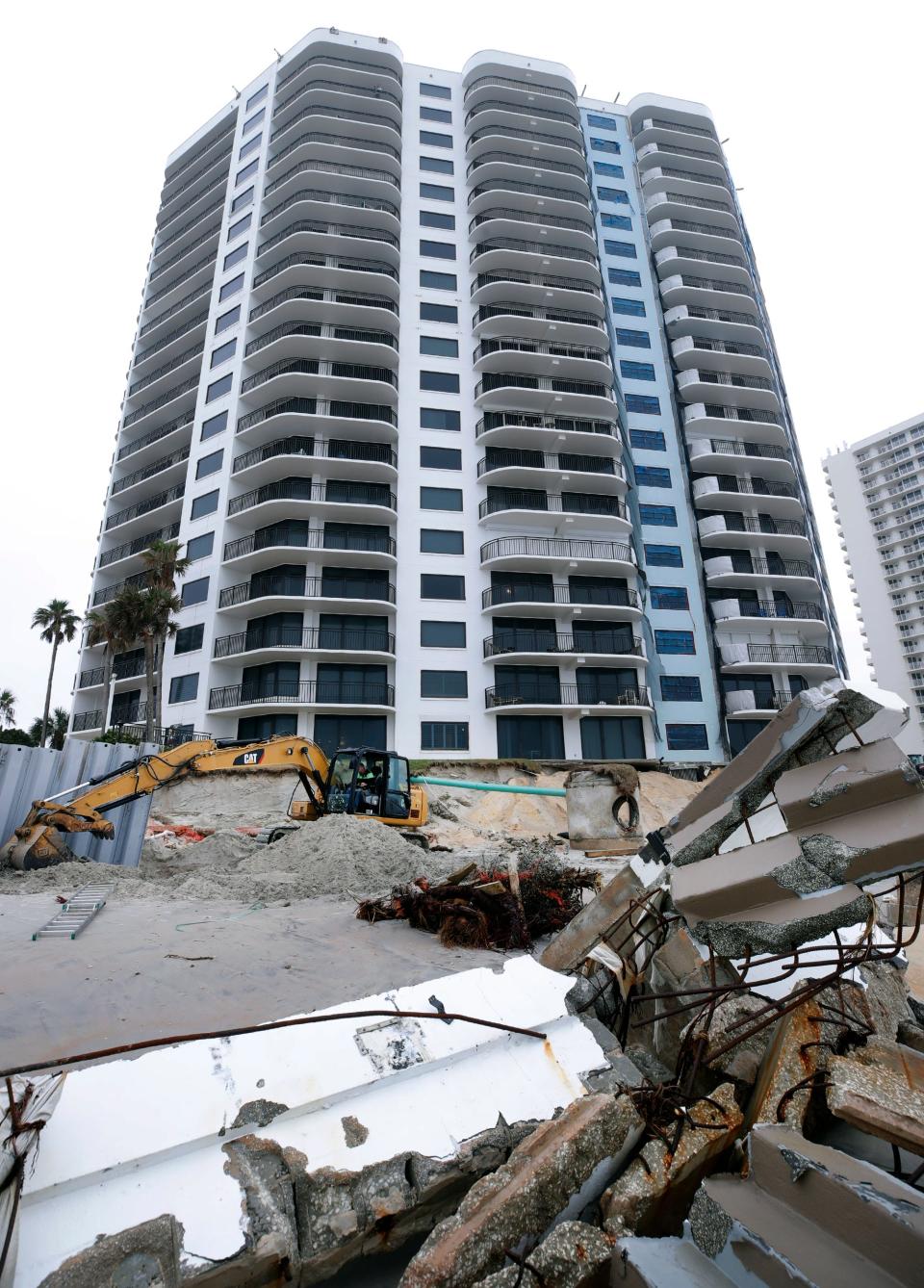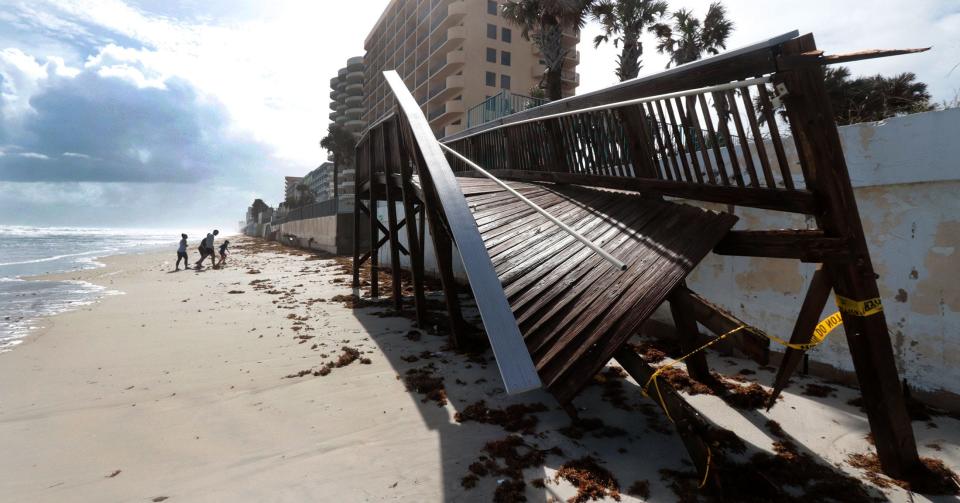Prepare for Idalia: Now is the time to make sure you're ready for a storm. Here's how
With Idalia expected to strengthen into a hurricane on Monday as it churns through the Gulf of Mexico toward the west coast and Big Bend areas of Florida, residents and visitors statewide should be making preparations to ride out the storm, according to the National Weather Service in Melbourne.
In Volusia and Flagler counties, the storm's effects are expected to arrive by Tuesday night, according to NWS forecasts. That means final preparations should be made as soon as possible today.

Fortunately, the second of Florida’s two disaster preparedness sales tax holidays started on Saturday, Aug. 26, and runs through Sept. 8. Tax-exempt items range from self-powered lights and radios to tarpaulins, AA-cell, AAA-cell, C-cell, D-cell, 6-volt, or 9-volt batteries and food coolers, among other items.
What do you need to do? Here’s a look at what you need to know:
When should you start hurricane preparations?
Get things ready early.
The National Hurricane Center, Florida Division of Emergency Management, AccuWeather, the Red Cross — and all other local, state and federal disaster officials — strongly encourage those living in a hurricane-prone area to assemble an emergency kit.
The best advice is to purchase, or update your kit from the prior year, well before a storm is approaching. That way you can avoid the long lines, empty shelves and stressed-out shoppers when a hurricane is on the way.
What should you include in a hurricane-preparedness kit?
Assemble these items now and put them aside in a spot where you’ll be able to quickly retrieve them. Keep heat-sensitive items inside your house and rotate the stock throughout the season:
Flashlights and extra bulbs.
Extra batteries.
Portable cellphone chargers. Keep them charged. Be sure to have charging cords and wall chargers in case the power is working in your shelter or another safe place.
Clock (wind-up or battery-operated).
Battery-operated radio.
NOAA emergency weather radio.
Toilet paper.
Matches (camping stores have waterproof matches).
Scissors.
Plastic garbage bags.
Working fire extinguisher.
Clean change of clothes, rain gear, sturdy swamp boots.
Fully charged battery-operated lanterns. Don’t use candles and kerosene lanterns. They are fire hazards.
List of phone numbers.
Copy of insurance policy.
What food supplies should you get for hurricane season?
Get enough nonperishable food to last two weeks. Keep in mind that canned and other prepared foods that are salty, dry or high in fat or protein might make for good provisions, but also will make you thirsty.
Water: Plan on 1 gallon of drinking water per person per day, for a minimum of one week. Water for two weeks is ideal. (Also, figure another 1 gallon per person/per day of water for washing hands, flushing toilets and for pets.)
Ice or dry ice.
Shelf-stable milk and juice boxes.
Canned and powdered milk.
Beverages (powdered or canned, fruit juices, instant coffee, tea).
Raw vegetables that don’t need refrigeration (will last only a few days).
Canned vegetables and fruits.
Dried fruits.
Prepared foods (canned soups, beef, spaghetti, tuna, chicken, ham, corned beef hash, packaged pudding).
Snacks (crackers, cookies, hard candy, unsalted nuts).
Snack spreads (peanut butter, cheese spreads, jelly).
Cereals.
Sugar, salt, pepper.
Bread.
Dry and canned pet food.
What tools and hardware should you put in your hurricane kit?
Hand tools: hammer, screwdrivers, shovel and pickax for after the storm.
Power screwdriver.
Quarter-inch machine screw sockets and screws.
Plastic sheeting to cover furniture.
Rope.
Sturdy working gloves.
Duct tape to waterproof items; masking tape isn’t strong enough.
Canvas tarps.
Sturdy nails.
What should be in a first-aid kit in your hurricane supplies?
Stores will be mobbed just before a storm and closed for days after. Keep a two-week supply of prescription drugs. Your first-aid kit should include:
Medical supplies.
First-aid handbook.
Insect repellent sprays.
Citronella candles, insect bite lotion.
Petroleum jelly for relieving itching.
Ointments for burns, cuts.
Antiseptic solution.
Sunscreen.
Extra over-the-counter medicine (for colds, allergies, cough).
Aspirin, acetaminophen, antacid.
Children’s medicines.
Diarrhea medication.
Feminine hygiene items.
Incontinence supplies.
Rubbing alcohol.
Iodine.
Disinfectant.
Wet wipes.
Moist towelette packets.
Medic Alert tags.
Thermometer.
Hypoallergenic adhesive tape.
Cotton-tipped swabs.
Sterile rolls.
Adhesive bandages.
Sterile gauze pads.
Roller bandages.
Tweezers.
Needles.
Adhesive tape.
Safety pins.
Latex gloves.
What kitchen supplies should you have in your hurricane prep kit?
Waterless hand sanitizer.
Manual can opener.
Water purification tablets.
Bottle opener.
Matches in a plastic bag.
Pocket knife.
Camp stove or other cooking device and plenty of fuel. (Use only canned fuel indoors — never charcoal or gas. Buy extra gas or charcoal to use in a well-ventilated space after the storm has passed.)
Ice chests or coolers.
Paper plates, napkins.
Plastic cups, utensils.
Disposable pans for cooking.
Plastic bags, jugs or containers for water and ice.
When should you fill up your car's gas tank before a storm?
Again, early preparation is key, before the lines start to form and supplies start to dwindle.

However you do it, keep your gas tank full. Stations could be without power for weeks after a catastrophic storm or it may be difficult for tankers to reach the area.
What items should be in a hurricane prep kit if you have a baby?
Keep these items in your supply kit:
Disposable diapers.
Baby wipes.
Diaper-rash ointment.
Baby medicines.
Medicine dropper.
Extra formula, baby food.
What items for an emergency toilet can be part of a storm prep kit?
Garbage can with tight lid.
Plastic bags for liners.
Disinfectant or bleach.
Deodorizer.
Extra toilet paper.
What are some water tips for hurricane preparations?
Special needs: Without air conditioning, your body is susceptible to heat stroke and dehydration. Have extra water for infants, youngsters, nursing mothers and the elderly.
Water in bulk: You can buy 5- and 10-gallon water bottles, but they’re hard to move. Or sanitize a large garbage can with a lid to store drinking water. Pour 1 cup of regular, unscented household bleach into 30 gallons of water; let stand overnight, drain and rinse well. Fill with tap water and replace the lid. Buy a long-handled ladle; keep paper cups nearby. Freezing jugs of water also helps keep foods frozen and provides chilled drinking water.
For household use, sanitize the bathtub by scrubbing well and rinsing with 1 cup of bleach in a tub of water. Let stand overnight; drain; refill. Use for flushing the toilet, but if necessary, for washing.
Keep water clean! Contaminated water can cause diarrhea, leading to dehydration. If drinking water is compromised, use it for washing up or flushing toilets. After a storm, do not use tap water for drinking unless you boil it for 3 minutes first or use purifying methods.
Wait until your utility or local government says water is safe to drink.
What are tips for storing ice during a hurricane?
Freezing water jugs: Buy 1-gallon containers of drinking water (2½ gallons, if your freezer will accommodate them), drain out about a half cup to leave room for expansion, seal tightly and freeze.
Keep jugs in the freezer even after the power goes out; they last longer than in coolers. Once thawed, water is drinkable. Put into smaller bottles to carry, or use it from the larger jugs, but keep it clean and uncontaminated.
Buy block ice if possible (from ice companies, boat supply stores and some grocery stores). It lasts up to three times longer than bagged, cubed ice.
Make your own blocks. When a storm approaches, clean the freezer and fill it with stackable containers of water. Large mixing bowls or small buckets work. Freeze, and when frozen, transfer ice blocks to sealable bags.
Buy extra coolers. Smaller areas are easier to chill. Once the power goes out, and foods begin to thaw or warm, pack them, tightly, into the bottom of the coolers, then top them with ice.
Try the bathtub. If you're not using the bathtub for water, use it for ice. Buy huge blocks and load the tub. Cover it with a tarp. Or fill with cubed ice; cover with newspapers and a heavy tarp, then a layer of plastic to keep cold in. Use a drain plug to save water for other uses.
Put foods under ice, not above it.
What are important documents to keep safe during a hurricane?
Important telephone numbers.
Record of bank account numbers.
Family records (birth, marriage, death certificates).
Record of credit card account numbers and companies.
Inventory of valuable household goods.
Copy of will, insurance policies, deeds, stocks and bonds.
Medical records.
Passports, Social Security cards, immunization records.
This article originally appeared on The Daytona Beach News-Journal: Idalia prep kits: What you need ahead of a storm's approach

